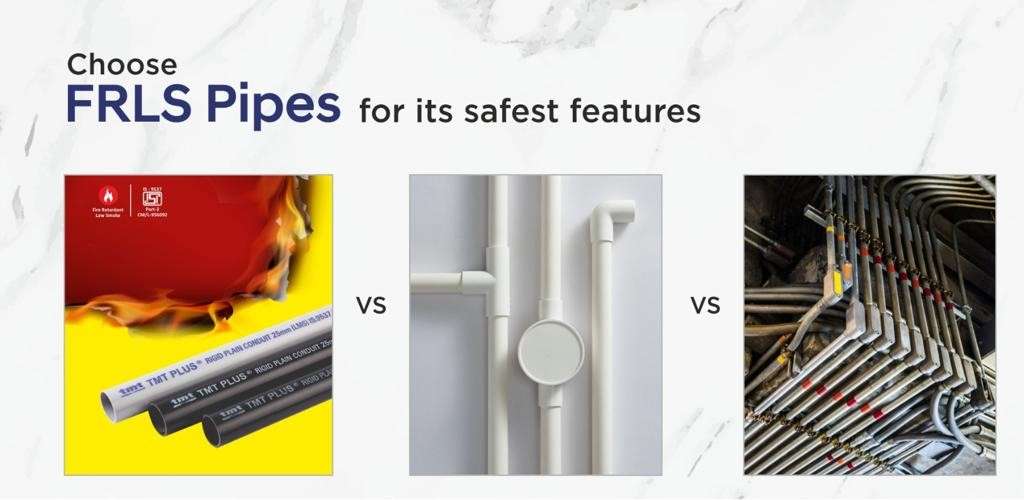Choose FRLS pipes for its safest features
Conduit pipes are channels that are used in the electrical wiring system. They’re typically made of metal or plastic and come in various diameters and lengths depending on the application. In this article we will be comparing three types of conduits, give you a lowdown on which one is best suited as per your requirements, and also which brand is right at the top when it comes to FRLS PVC conduit.
Conduit Pipe types:
FRLS (Fire-Retardant Low-Smoke): These PVC pipes prioritize safety, emitting minimal smoke and resisting fire spread in emergencies. They’re easy to work with and cost-effective, but compared to others, less flexible.
PVC (Polyvinyl Chloride): Affordable and lightweight, PVC pipes are common for basic electrical wiring. They handle chemicals and impacts well, but lack fire resistance and UV protection and have limited strength and bendability.
Metal (Steel, Aluminum): Prioritizing strength and fire resistance, metal conduits offer top-notch durability for demanding applications. Flexible options exist, but they are heavier, require specialized tools, and come with a higher price tag.
Features FRLS PVC Conduit Pipes
- FRLS PVC conduit has properties for enhanced safety in case of fire.
- Lightweight and easy to install, making them ideal for Do It Yourself (DIY) projects or large-scale construction.
- Corrosion-resistant and suitable for both indoor and outdoor applications.
- Cost-effective compared to metal conduits.
- Limited flexibility and strength compared to metal options.
Features of PVC Conduit Pipes
- Lightweight and cost-effective for basic electrical wiring needs.
- Easy to cut and join, making them convenient for quick installations.
- Good chemical and impact resistance for various environments.
- Not fire-retardant and not recommended for high-risk areas.
- Susceptible to UV degradation in direct sunlight.
- Limited strength and flexibility compared to metal conduits.
Features of Metal Conduit Pipes
- Excellent fire resistance and strength for optimal safety and durability.
- Flexible options like galvanized steel and aluminum cater to diverse needs.
- Corrosion-resistant and suitable for harsh environments.
- Heavyweight and require specialized tools for installation.
- More expensive than PVC and FRLS PVC options.
- Susceptible to rust if not properly coated or maintained.
Each type of conduit has its advantages and disadvantages, so the best choice for your project depends on factors like budget, safety requirements, and installation complexity.
Factors such as safety, ease of use, and cost play an important role in choosing the type of conduit for your system.
Let’s compare FRLS, PVC, and metal conduits to see their standings:
- Safety
FRLS PVC: This is the PVC conduit pipe for house wiring. It stands above the other two with its fire-retardant properties and low smoke emission, keeping everyone safe in case of electrical fires.
PVC: Doesn’t offer much fire protection, so it should be avoided in high-risk areas.
Metal: Has good fire resistance, providing an extra layer of security.
- Ease of use
FRLS PVC: Lightweight and easy to cut and join, making DIY projects and large-scale installations an easier task.
PVC: Lightweight and cheap, making it suitable for simple electrical jobs.
Metal: Heavier and requires specialized tools and skills, demanding more effort and expertise.
- Cost
FRLS PVC: Costlier than regular PVC but still budget-friendly.
PVC: The most affordable option, making it a popular choice for cost-conscious projects.
Metal: Weighs heavily on the wallet, making it the most expensive out of the three.
- Additional Parameters
Flexibility: FRLS PVC and PVC are less flexible than metal, which can be limiting in tight spaces. Metal offers more bendability, especially aluminum options.
Durability: Metal is supreme in strength and longevity, while PVC pipes are prone to cracking sometimes in extreme conditions. FRLS PVC stands in between these two and should be used.
Corrosion Resistance: All three options offer good corrosion resistance, though metal can rust if not properly coated.
Considering these points, each has its strengths and weaknesses, so the best choice depends on your priorities. In terms of safety, FRLS stands above others while PVC is the choice when it comes to ease of installation and affordability. Metal pipes are generally considered more durable and flexible, but are prone to rust.
TMT Plus FRLS and PVC conduit pipes for your homes are the best option
With adherence to impeccable standards, TMT Plus has the best PVC electrical conduit pipe. Their FRLS conduits are designed to offer a safe, long-lasting, and highly functional solution. Unlike others in the category, these pipes have excellent rigidity and high bending flexibility. Furthermore, they’re non-toxic and stand as a guarding agent in shielding wire in the event of a fire. Hence, while installing and laying the work of the electrical system, choose TMT Plus conduits for reliable protection.

As the editor of the blog, She curate insightful content that sparks curiosity and fosters learning. With a passion for storytelling and a keen eye for detail, she strive to bring diverse perspectives and engaging narratives to readers, ensuring every piece informs, inspires, and enriches.










